Neoclassicism in Paris
by Marc Haegeman
Serge Lifar (1905-1986), Ukranian and the last favourite of Diaghilev, directed the Paris Opera Ballet for almost thirty years until 1958. He was an influential dancer and a prolific choreographer, a notable dance theoretician and a tireless crusader for the values of neoclassical ballet, he had a keen eye for spotting talent, knew as no one else how to bring out the personalities of his dancers and successfully reinvigorated the company’s repertory and its standard. Yet for all that, the man is now more myth than reality, his ballets are often excused as passé, and unfortunately the public rarely ever comes to see anything substantial of his work outside of anniversaries or other special occasions. READ MORE
Beyond the Waltz: Austrodance Festival 2006
by Rita Felciano
 For dance observers not tuned in to the European festival circuits, contemporary dance in Austria is not exactly a hot item on the radar screen. Until a few years ago, their perceptions probably would have been right. But stage performances, archival and contemporary film footage during “Beyond the Waltz: Austrodance Festival 2006” convincingly showed that there is more to Vienna than ballet, secessionists and Strauss. READ MORE
For dance observers not tuned in to the European festival circuits, contemporary dance in Austria is not exactly a hot item on the radar screen. Until a few years ago, their perceptions probably would have been right. But stage performances, archival and contemporary film footage during “Beyond the Waltz: Austrodance Festival 2006” convincingly showed that there is more to Vienna than ballet, secessionists and Strauss. READ MORE
American Ballet Theatre's City Center Season - Four Reviews
War and Mozart
by Mary Cargill
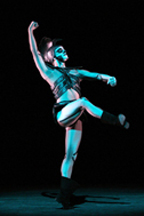 Balanchine’s lucid and shimmering “Symphonie Concertante” to Mozart’s music opened the mixed program—mixed indeed, with two great ballets surrounding a twitchy piece of mush. Veronika Part was injured, so the viola in “Symphonie Concertante” was danced by Paloma Herrera, accompanied by Michele Wiles and Maxim Beloserkovsky in his debut. Herrera and Wiles were better matched than Wiles and Part, but that really meant that both danced like extremely well-trained and dutiful students, with many moments of pure technical beauty but with little connection to the emotional undercurrents of the choreography. Beloserkovsky’s dancing suited this more idealized approach. He danced as if he were a partner in a dream, supporting first one woman, and then the other with a dignified diffidence and purity. READ MORE
Balanchine’s lucid and shimmering “Symphonie Concertante” to Mozart’s music opened the mixed program—mixed indeed, with two great ballets surrounding a twitchy piece of mush. Veronika Part was injured, so the viola in “Symphonie Concertante” was danced by Paloma Herrera, accompanied by Michele Wiles and Maxim Beloserkovsky in his debut. Herrera and Wiles were better matched than Wiles and Part, but that really meant that both danced like extremely well-trained and dutiful students, with many moments of pure technical beauty but with little connection to the emotional undercurrents of the choreography. Beloserkovsky’s dancing suited this more idealized approach. He danced as if he were a partner in a dream, supporting first one woman, and then the other with a dignified diffidence and purity. READ MORE
ABT's "Dark Elegies"
by Gay Morris
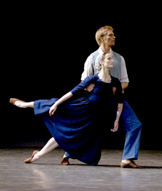 “Dark Elegies” made a fleeting appearance Thursday at City Center. Only one other performance of Antony Tudor’s great work was scheduled during American Ballet Theatre’s fall season. However brief its presence, “Dark Elegies” is always welcome. Its quiet truth grows with each viewing, and the ABT dancers give the ballet the kind of committed performance it deserves. The company is to be commended for sustaining Tudor’s vision at a time when so many works from the past are blurred or altered. READ MORE
“Dark Elegies” made a fleeting appearance Thursday at City Center. Only one other performance of Antony Tudor’s great work was scheduled during American Ballet Theatre’s fall season. However brief its presence, “Dark Elegies” is always welcome. Its quiet truth grows with each viewing, and the ABT dancers give the ballet the kind of committed performance it deserves. The company is to be commended for sustaining Tudor’s vision at a time when so many works from the past are blurred or altered. READ MORE
ABT: A full-company evening
by Susan Reiter
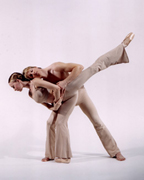 Somewhere in mid-June, as ABT is in the midst of rolling out one lavish production after another within the Metropolitan Opera House’s vast confines, we will look back extra-fondly on the terrific City Center season that makes possible a program as rewarding as this one. No work on the program had a cast of more than eight dancers, and none of them would come across nearly as well on the Met’s stage. So what may have been an evening off for most of the company’s corps de ballet was, for the audience, an evening of intimate moments and extremely fine dancing. READ MORE
Somewhere in mid-June, as ABT is in the midst of rolling out one lavish production after another within the Metropolitan Opera House’s vast confines, we will look back extra-fondly on the terrific City Center season that makes possible a program as rewarding as this one. No work on the program had a cast of more than eight dancers, and none of them would come across nearly as well on the Met’s stage. So what may have been an evening off for most of the company’s corps de ballet was, for the audience, an evening of intimate moments and extremely fine dancing. READ MORE
ABT: Mixed bill, uniform quality
by Carol Pardo
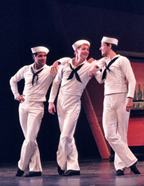 In its penultimate performance of the 2006 City Center Season, American Ballet Theatre presented three works of top-drawer choreography: Mark Morris’ “Drink To Me Only With Thine Eyes”, Antony Tudor’s “Dark Elegies” and Jerome Robbins’ “Fancy Free”. All three ballets showed stars, principals, soloists and members of the corps de ballet on a surprisingly equal footing, thus flattening the hierarchy so entrenched in the full-length ballets seen in the spring at the Metropolitan Opera House and providing a more comprehensive sense of the state of the company. READ MORE
In its penultimate performance of the 2006 City Center Season, American Ballet Theatre presented three works of top-drawer choreography: Mark Morris’ “Drink To Me Only With Thine Eyes”, Antony Tudor’s “Dark Elegies” and Jerome Robbins’ “Fancy Free”. All three ballets showed stars, principals, soloists and members of the corps de ballet on a surprisingly equal footing, thus flattening the hierarchy so entrenched in the full-length ballets seen in the spring at the Metropolitan Opera House and providing a more comprehensive sense of the state of the company. READ MORE
Individuality but not satisfaction
by John Percival
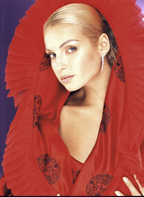 MMM = Michael's Modern Masterpiece. Michael Clark first tackled Stravinsky's “Rite of Spring” when he was 30 and had been making choreography for ten years, not only for his own company but for the Paris Opera, the Deutsche Oper Berlin, and in Britain for Scottish Ballet, London Festival Ballet, Ballet Rambert and Phoenix Dance; he was widely recognised as our best creative and performing talent. That was in 1992. He has since had a period of inactivity (drugs were to blame), then latterly has made less frequent productions in which his own entries—yes, he still appears prominently—are less demanding. Appointed an artistic associate of London's Barbican Centre, he is undertaking a three-part Stravinsky project. Last year's “O”, built around “Apollo”, and this year's “MMM...” (“Rite”) are both reworkings of earlier productions, neither of them looking as good as before, even though he has a larger company this year. READ MORE
MMM = Michael's Modern Masterpiece. Michael Clark first tackled Stravinsky's “Rite of Spring” when he was 30 and had been making choreography for ten years, not only for his own company but for the Paris Opera, the Deutsche Oper Berlin, and in Britain for Scottish Ballet, London Festival Ballet, Ballet Rambert and Phoenix Dance; he was widely recognised as our best creative and performing talent. That was in 1992. He has since had a period of inactivity (drugs were to blame), then latterly has made less frequent productions in which his own entries—yes, he still appears prominently—are less demanding. Appointed an artistic associate of London's Barbican Centre, he is undertaking a three-part Stravinsky project. Last year's “O”, built around “Apollo”, and this year's “MMM...” (“Rite”) are both reworkings of earlier productions, neither of them looking as good as before, even though he has a larger company this year. READ MORE
Impermanence in action
by Tom Phillips
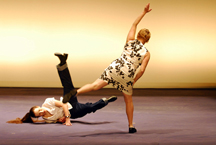 Impermanence is a fundamental concept of Buddhism, and it is an empirical concept, not derived from any philosophical inquiry but from experience itself. Meredith Monk, a practitioner of Buddhist meditation, experienced it with the death of her long-time partner in 2003, and after that in workshops she led with hospice patients in Britain. “Impermanence” is an artistic response to their suffering and her own, but with minimal sentimentality or self-pity. READ MORE
Impermanence is a fundamental concept of Buddhism, and it is an empirical concept, not derived from any philosophical inquiry but from experience itself. Meredith Monk, a practitioner of Buddhist meditation, experienced it with the death of her long-time partner in 2003, and after that in workshops she led with hospice patients in Britain. “Impermanence” is an artistic response to their suffering and her own, but with minimal sentimentality or self-pity. READ MORE
Neoclassicism in Copenhagen
by Eva Kistrup
 Halfway through Uwe Scholtz "Schumann's 2nd Symphony," I wished someone had written a manual on how to choreograph a neo-classical ballet. It is not the first time I have had that wish but it is seldom that the need for a manual has been so acute. One might add that the manual should be based on the Balanchine repertoire, and it was clear that Scholtz had seen some Balanchine work. He is even quoted in the programme as wishing that the work be viewed as a mixture of Cranko and Balanchine. One can see what he means. Scholtz had a very clumsy copy of the brilliant moment in "Serenade," where the “angel” girl is standing in a high arabesque and is turned by her kneeling partner. The difference is that in "Serenade," the mechanics are hidden by the long skirt, whereas in "Schumann" it is done with the tricot-clad leg totally visible to the audience and thereby lacks the mystique on how this movement is physically possible. Trust Scholtz to expose the magician's tricks without being able to make any of his own. READ MORE
Halfway through Uwe Scholtz "Schumann's 2nd Symphony," I wished someone had written a manual on how to choreograph a neo-classical ballet. It is not the first time I have had that wish but it is seldom that the need for a manual has been so acute. One might add that the manual should be based on the Balanchine repertoire, and it was clear that Scholtz had seen some Balanchine work. He is even quoted in the programme as wishing that the work be viewed as a mixture of Cranko and Balanchine. One can see what he means. Scholtz had a very clumsy copy of the brilliant moment in "Serenade," where the “angel” girl is standing in a high arabesque and is turned by her kneeling partner. The difference is that in "Serenade," the mechanics are hidden by the long skirt, whereas in "Schumann" it is done with the tricot-clad leg totally visible to the audience and thereby lacks the mystique on how this movement is physically possible. Trust Scholtz to expose the magician's tricks without being able to make any of his own. READ MORE
Serious danger
by Lisa Rinehart
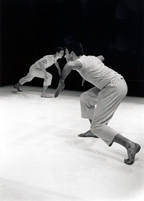 Dimitri Chamblas and Boris Charmatz are French intellectuals who like to get physical. Contradiction, you say? Not really. In 1993, 17-year-old Chamblas and 19-year-old Charmatz created the intimate and visceral "A bras le corps" as a challenge to the then visually baroque conventions of French contemporary dance. As teenagers are wont to do, they worked to be different, boxing the dance into a tight square of seats that literally put the action into the viewers' laps. They eschewed music, using only a few bits of Paganini in moments of stillness, and made the dance difficult enough to test the limits of their youthful bodies. They wore simple white pants and shirts, and wowed French audiences with a sweat soaked display of physicality often compared to a sparing match between friends. It was a big hit, and Chamblas and Charmatz could have easily started a company. Except they didn't want to be full-time choreographers. They wanted to be free to pursue other interests, dance with other companies, and to reunite periodically to perform the duet as they aged. They decided their teenage rebellion would be a litmus test, if you will, of their evolution as artists. READ MORE
Dimitri Chamblas and Boris Charmatz are French intellectuals who like to get physical. Contradiction, you say? Not really. In 1993, 17-year-old Chamblas and 19-year-old Charmatz created the intimate and visceral "A bras le corps" as a challenge to the then visually baroque conventions of French contemporary dance. As teenagers are wont to do, they worked to be different, boxing the dance into a tight square of seats that literally put the action into the viewers' laps. They eschewed music, using only a few bits of Paganini in moments of stillness, and made the dance difficult enough to test the limits of their youthful bodies. They wore simple white pants and shirts, and wowed French audiences with a sweat soaked display of physicality often compared to a sparing match between friends. It was a big hit, and Chamblas and Charmatz could have easily started a company. Except they didn't want to be full-time choreographers. They wanted to be free to pursue other interests, dance with other companies, and to reunite periodically to perform the duet as they aged. They decided their teenage rebellion would be a litmus test, if you will, of their evolution as artists. READ MORE
San Franciso Letter No. 17
Cloud Gate Dance Theater and Lyon Opera Ballet
by Rita Felciano
When watching dance, a score’s connection to the piece often gets shortchanged. Maybe because we are better trained to take in information visually, we turn out aural cues in order to focus on what our experience tells us is the important task at hand. Ideally, visual and sound blend, or at least feed off each other but the relationship between the two arts is not always easily decipherable. READ MORE
Positive and exciting risk taking
by Naima Prevots
Positive and exciting risk taking marked the evening’s performance of The Washington Ballet. The company achieved new dimensions of maturity and excellence as it tackled the demanding nuances of Jerome Robbins’ In the Night (music: Frederic Chopin), and the driving energies of Twyla Tharp’s In the Upper Room (music: Phillip Glass). The program also featured the world premiere of Septime Webre’s oui/non, set to French cabaret songs, sung on stage by vocalist Karen Akers. As the company’s Artistic Director, Webre has in the past created large and spectacular group dances. Although not fully realized choreographically, his new work focuses on couples and intimacy, and shows him taking greater risks with deeper expressive possibilities. READ MORE